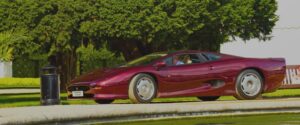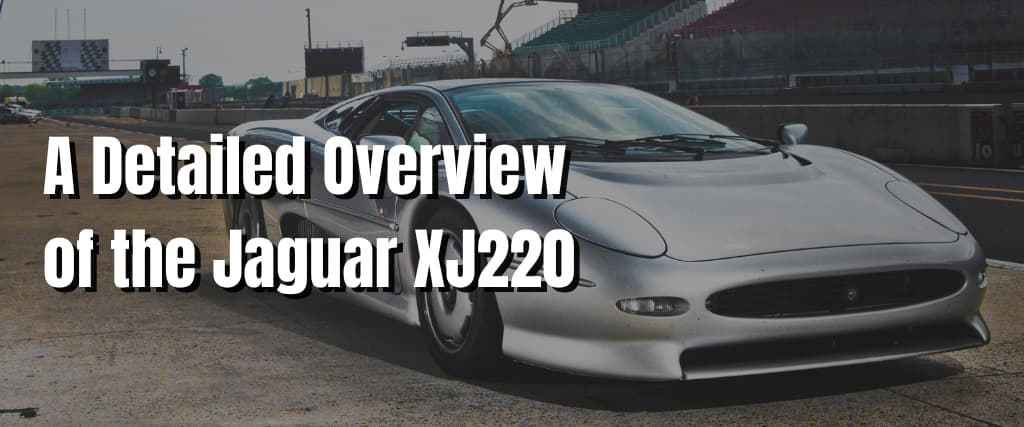In the history of supercars, few vehicles have left as indelible a mark on critics and car lovers as the iconic Jaguar XJ220.
The car is considered one of the most revered supercars of the 1990s and was born during a time of ambitious engineering and dreaming – representing British automotive committed to excellence and overall ambition.
This article delves into the past to bring back the Jaguar XJ220’s story. Highlighting how it defied convention, set world records and continues to captivate automotive enthusiasts worldwide.
So join us as we embark on a comprehensive review of the iconic vehicle, covering its history, design, performance, driving experience and lasting impact on the automotive industry.
History and Origins

The story of how the Jaguar XJ220 came to be is a captivating tale of automotive brilliance.
In the 1980s, Jaguar and Tom Walkinshaw Racing (TWR) collaborated to create what would become the XJ220. Their goal was to turn the successful Jaguar XJR-9 race car into a production supercar that would redefine performance expectations. This ambitious project, inspired by the world of racing and its constant pursuit of innovation and speed, paved the way for the birth of the Jaguar XJ220.
Subsequently, this car not only revolutionised the standards of the road but also secured its place in automotive history as a legend of the supercar world.
Design and Styling
One of the most striking aspects of the Jaguar XJ220 is its timeless design. Designed by Keith Helfet, the XJ220’s exterior is a symphony of smooth curves and sharp lines. At first glance, it’s evident that the car was built firmly with aerodynamics in mind. The sleek, low-slung body is not only visually appealing but also functional, with a drag coefficient of a mere 0.36.
The car’s iconic scissor doors, a feature that became synonymous with the XJ220, add to its exotic appeal. These upward-opening doors not only have a ‘wow’ factor but also make getting in and out of the vehicle a dramatic experience.
The XJ220’s design is characterised by its elongated front end, which houses a massive air intake and a set of distinctive circular headlights. Moving towards the rear, you’ll notice the integrated rear wing that can adjust its angle to optimise downforce. The XJ220’s twin-exhaust system is artfully integrated into the rear diffuser, adding a touch of sportiness to the design.
Overall, the Jaguar XJ220’s design remains a timeless masterpiece, blending aerodynamic efficiency with aesthetics in a way that few cars of its era managed to achieve.
Performance and Powertrain
Under the XJ220’s hood lies a powertrain that defines the very essence of a supercar.
At the heart of this beast is a 3.5-litre, twin-turbocharged V6 engine that produces a staggering 542 horsepower and 475 lb-ft of torque. These numbers were mind-blowing in the early ’90s and allowed the XJ220 to accelerate from 0 to 60 miles per hour in just 3.6 seconds, making it one of the fastest production cars of its time.
Power is channelled to the rear wheels through a five-speed manual transmission, which provides an engaging driving experience that purists still appreciate today. The XJ220’s rear-wheel-drive setup might be challenging to handle for some, but it rewards skilled drivers with an exhilarating connection to the road.
The car’s top speed, a breathtaking 213 miles per hour, was a world record at the time. The XJ220 held this title for several years, solidifying its reputation as an outright speed demon.
Handling and Ride Quality

The Jaguar XJ220’s prowess extends beyond sheer power; it reflects meticulous engineering in every aspect, including its handling.
With a double-wishbone suspension at all four corners, the XJ220 offers a balanced, responsive ride that feels remarkably connected to the road. The low centre of gravity and aerodynamic design provide exceptional stability, especially when pushing the car to its limits.
Yet, it’s not a car for the faint of heart. The rear-wheel-drive setup demands respect and skill, particularly in challenging conditions. However, for those who master its nuances, the XJ220 delivers a rewarding and engaging driving experience that few cars can match.
Furthermore, its adjustable suspension allows drivers to tailor the ride to their preferences, transforming it from a comfortable grand tourer to a track-focused performance machine at the push of a button. Ultimately, in the world of supercars, the Jaguar XJ220 remains a masterpiece of handling dynamics, offering an unforgettable connection between driver and machine.
Interior and Comfort
As soon as you step inside the Jaguar XJ220, you’ll find a blend of luxury and performance that defies the stereotype of the spartan supercar cockpit.
The interior of the XJ220 embodies thoughtful design and attention to detail. Plush leather seats provide excellent support, ensuring comfort and stability during long-distance journeys and spirited driving. While the cabin may not offer the spaciousness of a luxury sedan, it envelops the driver and passenger in an atmosphere of refinement.
The quality of materials used throughout the interior exudes a sense of opulence, albeit focusing on function over excess. Though the XJ220 is designed primarily for performance, it doesn’t compromise on comfort, making it a capable grand tourer that can easily traverse vast distances.
Overall, the interior of the Jaguar XJ220 strikes an impressive balance between supercar performance and the creature comforts expected in a vehicle of its pedigree.
Technology and Features
The Jaguar XJ220 hails from an era when supercar technology was more about raw power and mechanical prowess than digital wizardry.
As such, it lacks the advanced technological features that have become commonplace in modern high-performance vehicles. Its instrumentation is delightfully analogue, with straightforward gauges providing essential information to the driver. Creature comforts are limited to basics like air conditioning and a modest audio system, reflecting the era’s priorities of weight reduction and pure driving engagement.
While it may lack the cutting-edge tech amenities of contemporary supercars, the XJ220’s appeal lies in its unfiltered driving experience, reminding enthusiasts of a time when the road was conquered by the skill of the driver rather than the assistance of technology.
In this sense, the Jaguar XJ220 stands as a relic of the past, an icon of mechanical brilliance in an era before computers dominated the driving experience.
Ownership Experience and Maintenance

Owning a Jaguar XJ220 is a dream come true for many car enthusiasts, but it’s important to consider the realities of maintaining such a rare and exotic machine. Finding replacement parts can be a challenge, and specialised knowledge is required to keep the car in optimal condition.
Regular maintenance for the XJ220 includes routine engine and transmission servicing and care for the delicate suspension components. Additionally, the turbochargers may require attention over time, as they can be prone to wear and tear.
Due to the car’s rarity and historical significance, there are dedicated XJ220 specialists and enthusiast communities that can provide valuable support and resources for owners. However, potential buyers should be prepared for the commitment and costs associated with maintaining this iconic supercar.
Legacy and Impact
The Jaguar XJ220 left an indelible mark on the automotive world, not only for its performance capabilities but also for its role in pushing the boundaries of what was possible in the early ’90s. It showcased that British engineering could compete on a global scale in the supercar arena.
One of the XJ220’s most enduring legacies is its influence on Jaguar’s future performance models. While the XJ220 itself remained a limited-production vehicle, its technological innovations and design cues found their way into subsequent Jaguar models, including the XKR and the F-Type.
Moreover, the XJ220’s top speed record stood for several years, illustrating its pioneering spirit and ability to challenge the established supercar hierarchy.
Conclusion
The Jaguar XJ220’s allure extends far beyond its original production run in the 1990s. Today, it remains a sought-after collector’s item and a symbol of automotive excellence. Its timeless design continues to turn heads and its performance figures – while surpassed by some modern supercars – still command respect, given the context of the time in which it was built.
For those fortunate enough to own or experience an XJ220, it’s a connection to a bygone era of automotive enthusiasm, when cars were celebrated for their raw power and elegance. It’s a reminder that even in the world of high-tech hybrid hypercars and electric supercars, there’s a place for the classics that set the stage for the future.
Ultimately, the Jaguar XJ220 is not just a car; it’s an icon – a symbol of what happens when engineering brilliance meets unbridled ambition. From its sleek design to its spine-tingling performance, the XJ220 continues to captivate automotive enthusiasts and remind us of the golden era of supercars.
If you ever have the opportunity to see, drive, or even own one, don’t hesitate to embrace the chance to experience a piece of automotive history that roars with power and elegance.


